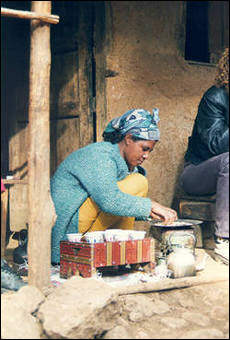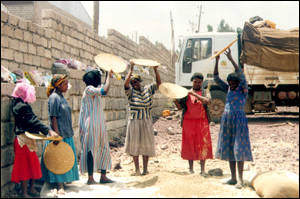 COFFEE CEREMONY COFFEE CEREMONY |
->Market liberalization
Atsede then sits down and the ceremony begins in earnest. A handful of coffee is gently washed and spread out on the heated pan, which, in the old days, was made of clay. While the coffee beans are stirred and shaken, and the husks blown away, roasted sorghum, a cousin of popcorn, is passed round amid general conversation. The atmosphere is light-hearted rather than solemn, and a feeling of well being begins to develop.
Anyone who has lived in Ethiopia will have experienced the rattle of the coffee beans, heralding the delicious fragrance of roasted coffee. The beans now shine as the aromatic oil is coaxed out of them. When they have turned a very dark brown, Atsede brings the pan round to each of us, shaking the beans so we can better inhale the coffee smoke rising of the hand to bring the aroma closer to our noses. Deftly, she removes one or two small lumps of charcoal from the brazier and places them on top of the small incense burner.

The cream-coloured incense crystals are now thrown on to the burning charcoal and, a few seconds later, the air is filled with the smoke and aroma of incense, mingled with the coffee fumes.
Traditionally, at this juncture, the officiant would disappear to grind the coffee beans with a wooden pestle and mortar. Atsede also disappears, but what we hear instead of the pounding in the drone of the electric coffee grinder. Before leaving the room, she has filled with water and placed on the brazier a jebena, a delicate little pot, rounded at the bottom and with a pointed spout and a long, shapely neck, and closed with a minute straw'hat'.
We talk, waiting for the steam to rise. Atsede adds surprisingly little coffee to the water in the pot and then pours some of the mix into a cup. Several times, just before the coffee boils, she adds some liquid from the cup to cool the brew, until, finally, the coffee is ready. With a graceful movement, she lifts the jebena and, holding it high, aims the totally black drink at the middle of each of the little cups. She fills them to the brim without spilling any liquid. | I am always surprised to see how many cups of coffee emerge, as if by magic, from the little pot. We do our best to add the sugar with equal adroitness, but with less success. Sometimes, a sprig of rue from the garden is added to the coffee.
Now, we are all ready to drink the first round, known as awol, a word of Arabic origin, meaning 'first'. Though strong, the coffee has no bitter taste.
The jebena is refilled with water and there is more talking and consumption of popped sorghum. Unpopped roasted barley or Ethiopian bread is also sometimes served, and at times Atsede substitutes real popcorn. When there are many guests and not enough cups to go round, or it becomes difficult to remember to whom each cup belongs, a bowl if water will have been brought in for rinsing the cups between rounds.
The second brew is now ready. It is weaker that the first, as no further coffee has been added. This new round is called tona, from the Arabic thani, meaning 'second'.

If by now we have succeeded in forgetting how much time we have idled away, we feel very relaxed indeed.
The third and final brew is made by again adding water to the original coffee, and bringing it to the boil. This last brew is called baraka, which means 'blessing' in several Semitic languages, among the Arabic and Ge'ez, the Ethiopian ecclesiastical language. When we have finished slowly sipping for the third time, we are all in a benign mood. We thank Atsede, and return to our daily routine.
Like so many Ethiopian customs, today's coffee ceremony is an amalgam of the traditional and the modern, the local and the foreign. It is yet another example of the way Ethiopia absorbs influences from many sources and, in time, combines them into something which, while subject to continuing change, is nevertheless unique unto itself. |

